|
Well, after all our effort and patience, we've finished building and painting our model, according to the version we've chosen. We should say that depending on the experience and ability of each modeler, the finished product will show different grades of detailing and/or modifications to the original kit, but I'm sure that all of us will surely be satisfied with the final results.
We now have reached the stage in which our job could be enhanced and our effort rewarded by success, or we can ruin all the careful work that we have put on the model. As many of you may have already deduced, I am talking about the "weathering" process
|
This process tries to reproduce both climatic effects and natural illumination in the scale model; being a reduced scale we must emphasize this, in order to enhance the three-dimensional look.
|
The "weathering"
I know that this is not a new topic in modelling, it is easy to find a certain number of references about the most common and well known techniques. In fact, you can read about that on the Web, as well as in printed publications, it's one of the most widely used techniques modelers worldwide. In spite of this, it is also one of the most dynamic, rich and creative techniques in our hobby. It has been changing during the last years, from washes and drybrushing to extremes of superdetailing, although the current tendencies is to almost completely avoid them.
|
In this section, we'll try to present the reader with a set of techniques and methods to reproduce the different effects that outdoor operation, the action of weather, and even the use itself, cause on vehicles of all kinds. For the final selection of techniques that we're going to use, the version and geographical, as well as seasonal deployment, of the model, will be of main importance, since they will define how would weather conditions affect a real vehicle. According to this, a model of an Israeli M-113, would show a dusty and "earthy" appearance for a vehicle operating in the dry season in the Negev desert, but it also could have a heavy amount of mud and even snow if the same vehicle is operating in the Golan heights, during the winter. We will start our approach making a brief description of the most spreaded techniques to
give our model a more real and less "toyish" appearance.
|
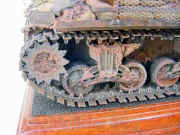
|
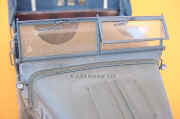
|
After finishing painting the vehicle, we can choose one or more of the following techniques:
Washes
The main purpose of washes is to emphasize the details enhancing the "shadow" effect in engraved panels, nuts, bolts, hatches and so on. To achieve this, we have to gently "wash" the model with a mixture of dark colored paint (usually chocolate, black or a combination of both) and thinner. The paint thinner ratio would change depending on the modeler's choice, but an adequate ratio to start with, would be 70 or 80% of turpentine or thinner and 30 or 20% of paint. This will give a mixture with a dirty-thinner appearance. We'll then start to apply this mixture with a #6 or #8 brush, preferable round and soft, covering the whole model but aiming our main effort to the above mentioned areas. The idea is accumulate this mixture around these areas, giving a darker tone to the recessed parts, thus enhancing the shadow appearance.
Another way to achieve the same effect without the use of washes, is to apply the model a base coat of a dark color complementary of the final color of the vehicle (such as chocolate for sand or earth brown, dark olive for green, etc.). Then we will spray thin layers of the final color, leaving the darker color exposed in the recessed parts.
|
Filters
Even though they're not as widely used as washes, filters are a very interesting tool when our model shows a monochrome scheme. Its goal is to provide different shades to the boring color of the vehicle. Unlike washes, the idea is not to leave the "washed" paint to flow around recessed lines and selected details, but to slightly cover the flat surfaces of the model, changing the original color of it. Some experienced modelers take advantage of this technique to achieve the final color of the vehicle, obtaining shades that would be difficult to find through the direct mixing of paints. Final result is similar to the photograph taken with filters, changing the basic color over which they're applied. Basically, you have to apply an even more diluted mixture of paint and thinner, in this technique. A good ratio would be 95% of turpentine or
thinner and 5% of paint.
|
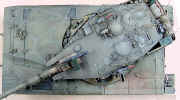
|
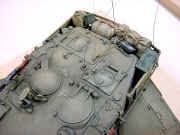
|
Drybrushing
This technique complements the previous ones, it highlights the raised details of the model, to increase the three-dimensional sensation. As its name clearly states, it is done by the use of a flat, very soft bristled brush; taking some base paint slightly lighter in color, removing almost all paint with a dry clean cloth, and leaving hardly a bit of paint on the bristles. Then we proceed to gently "brush" the raised details, enhancing this way the sensation of light reflecting on them.
Chipped paint
|
This technique tries to reproduce the paint chipping, which shows either the primer color or plain metal through the camouflage paint. The best way to achieve this, if you're going to remove a wide area, is to give this area a base layer of bright metal, masking it afterwards and applying a rust color layer, masking again leaving a thin outline of rust surrounding the metal color, repeat the process applying this time a primer color (if it fits to the selected vehicle) layer, and finally painting the vehicle in its camouflage color.
Once the paint dries (better leave it for 24 hours to dry, or so), remove masking so you obtain a metal colored central area, surrounded by a tiny ring of rust, and around this, the base color of the vehicle.
|
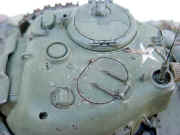
|
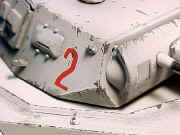
|
Besides providing a highly accurate reproduction, this method is very tedious and not easy to achieve. When you want to reproduce tiny chips or "RASPONES", as we call them in Spanish, you reproduce them with a pencil, applying it directly over the base color where you want to simulate the effect. If you use a soft pencil lead you'll obtain a darker metal color, like gun metal; if you use a harder one, you'll get a silver appearance. The final result depends on each one's preference.
Dust effect
This step tries to reproduce the overall dust layer, common to all the vehicles after a brief period on the field. The two most commonly used techniques to achieve this are: spraying the model with an aerograph, using a kakhi or light earth color, until you achieve the desired result; or by applying artist chalk pastels, after sanding them to obtain a very fine "dust", and apply it on the model at will, with a soft brush. If you decide to use the pastel chalk technique, you must take care not to touch the "dusted" areas because it surely will remove the fine dust previously applied, or leave finger marks on them.
Complementary techniques
Besides the described ones, which are the tools we will use more frequently in our models, according to historical and geographical background, we would use one or more of the following.
Rust
This is one of the effects that you must aplly with great care. Being one of the most visually attractive and eye-catching effecs, we must take into consideration that, apart from tracks or around nuts, bolts, rivets, etc., the presence of rust streaks in noticeable proportions, will only appear when the vehicles are exposed to rainy and wet climate conditions during long periods (even weeks).
Oil and fuel stains
Once again, placement of this kind of stains has to be done accordingly to a logical criteria, so they will be found around fuel and oil filler caps, as well as in heavy maintenance areas. An adequate way to reproduce them is to apply a heavier wash made out of flat black paint with a grey, or eventually a brown tint, such as burnt sienna. Practice will let you find the mixture that best satisfies your own preferences. I strongly suggest to try this technique after the whole weathering process, so it will remove dust and cover the other effects, just as it happens in real life.
|
Mud
Another huge temptation, that may ruin our whole work if we exaggerate this effect. Even though not all of us have a tank "near home", to go and see how it gets the muddy tracks, we can easily find a building or construction site where we can see Caterpillars and Bulldozers, in which dust and mud effects are very alike to the ones in armored vehicles.
|
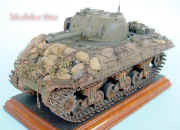
|
Here again, we must overcome the temptation to overdo the effect, and make it look real.
Replicating the mud in scale
A good way to replicate mud in scale is preparing a mixture of the following:
 Earth color Acrylic or Tempera paint Earth color Acrylic or Tempera paint
 Chalk pastels, sanded. You can eventually use powdered coffee, adjusted to the consistency and thickness to be acquired. Chalk pastels, sanded. You can eventually use powdered coffee, adjusted to the consistency and thickness to be acquired.
 Static grass Static grass
 White glue White glue
 Water, in proper quantity for the desired consistency. I would suggest to start with a thickness close to the tempera paint one. Water, in proper quantity for the desired consistency. I would suggest to start with a thickness close to the tempera paint one.
We'll apply this mixture with a brush, on the areas to be covered with mud, always having at hand some visual reference to get the best effect. Once we finish applying this mixture, we can further enrich the appearance adding more dry static grass and chalk pastels powder.
As for the paint thinning techniques, we've been referring to turpentine, but you can also use other kinds of thinner (here, you should do some trying and testing, in order to find the best brand and quality choice, always looking for the less greasy type), as well as lighter-fluid (this leaves less shiny lines than thinner). The best paints for washes, filters, etc., would be enamels, or oils, taking into account that these ones need a longer (and I mean really longer) time to dry, which would delay the weathering process, but they allow to take advantage of other techniques such as "merge" and "blend" colors, etc.
Summing up
In fact, there are as many "weathering schools" as modelers, but we can assure you that currently there are at least two prevailing tendencies with different and even opposed criteria when it comes to weathering. The most recent ones are a full 180° apart from the described techniques, which can be considered more traditional and widely known, and favors a more visual attractive aesthetic, like light-and-shades. The aim is to reproduce with more fidelity, the effects produced by the climatic agents, as well as the chronological way in which they occur.
On the other hand, painting is not the only thing to consider, when we try to give a "used" appearance to our models. A mostly forgotten topic is, the consequences of daily use of the vehicle. This way, tiny dents or broken metal parts, distributing them accordingly to logical places (obviously we are not going to dent or bump structural areas or main armor parts, due to their thickness and hardness), will add a lot to the final appearance of our model. But we will explain this in another note...
There are other complementary techniques that may enrich the final appearance of the model, but generally speaking, they variations of those described in this note.
As we already said, in future issues we will tackle more deeply, and in a detailed way, these and other methods to enhance the appearance of our model accordingly to the right environment for the version we chose.
Some models shown belong to Pablo Scordo, Carlos Massu and Nicolas Fiorentini, we thanks they to let use their photos for this note.
|